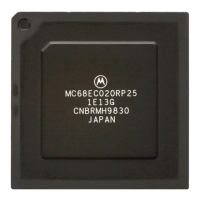MOTOROLA M68020 USER’S MANUAL 7- 11
After evaluating the condition, the coprocessor returns a true/false indicator to the main
processor by placing a null primitive (refer to 7.4.4 Null Primitive) in the response CIR.
The main processor completes the coprocessor instruction execution when it receives the
condition indicator from the coprocessor.
1 RECOGNIZE COPROCESSOR INSTRUCTION F-LIN
PERATION WORD
2 WRITE COPROCESSOR CONDITION SELECTOR TO
O NDITION CIR
3 READ COPROCESSOR RESPONSE PRIMITIVE CO
ROM RESPONSE CIR
) PERFORM SERVICE REQUESTED BY RESPONSE
RIMITIVE
) IF (COPROCESSOR RESPONSE PRIMITIVE
NDICATES "COME AGAIN") GO TO M3
SEE NOTE)
4 COMPLETE EXECUTION OF INSTRUCTION BASED
N THE TRUE/FALSE CONDITION INDICATOR
ETURNED IN THE RESPONSE CIR
1 DECODE COMMAND WORD AND INITIATE
OMMAND EXECUTION
2 WHILE (MAIN PROCESSOR SERVICE IS REQUIRED)
O STEPS 1) AND 2) BELOW
) REQUEST SERVICE BY PLACING APPROPRIATE
RESPONSE PRIMITIVE CODE IN RESPONSE CIR
) RECEIVE SERVICE FROM MAIN PROCESSOR
3 COMPLETE CONDITION EVALUATION
4 REFLECT "NO COME AGAIN" STATUS WITH TRUE/FA
ONDITION INDICATOR IN RESPONSE CIR
MAIN PROCESSOR
OPROCESSO
NOTE: All coprocessor response primitives, except the Null primitive, that allow the "Come Again" primitive attribute
must indicate "Come Again" when used during the execution of a conditional category instruction. If a "Come
Again" attribute is not indicated in one of these primitives, the main processor will initiate protocol violation
exception processing (see 7.5.2.1 Protocol Violations).
Figure 7-8. Coprocessor Interface Protocol
for Conditional Category Instructions

